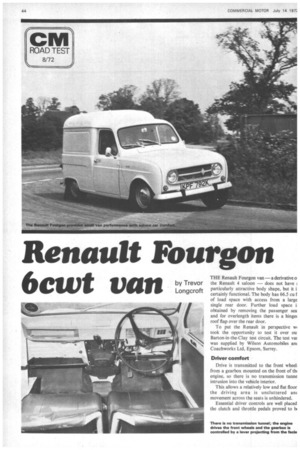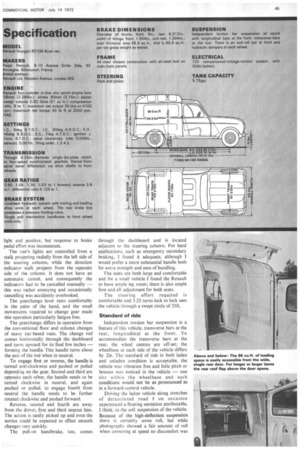Renault Fourgon (mut van
Page 44

Page 45

Page 46

If you've noticed an error in this article please click here to report it so we can fix it.
by Trevor Longcroft
THE Renault Fourgon van— a derivative o the Renault 4 saloon — does not have particularly attractive body shape, but it i certainly functional. The body has 66.5 Cu f of load space with access from a large single rear door. Further load space i: obtained by removing the passenger sea and for overlength items there is a hinge( roof flap over the rear door.
To put the Renault in perspective wi took the opportunity to test it over cu: Barton-in-the-Clay test circuit. The test vai was supplied by Wilson Automobiles an Coachworks Ltd, Epsom, Surrey.
Driver comfort Drive is transmitted to the front wheel: from a gearbox mounted on the front of thi engine, so there is no transmission tunne intrusion into the vehicle interior.
This allows a relatively low and flat floor the driving area is uncluttered an movement across the seats is unhindered.
Essential driver controls are well placed the clutch and throttle pedals proved to 134 light and positive, but response to brake pedal effort was inconsistent.
The van's lights are controlled from a stalk projecting radially from the left side of the steering column, while the direction indicator stalk projects from the opposite side of the column. It does not have an automatic cancel, and consequently the indicators had to be cancelled manually — this was rather annoying and occasionally cancelling was accidently overlooked.
The gearchange lever rests comfortably in the palm of the hand, and the small movements required to change gear made this operation particularly fatigue free.
The gearchange differs in operation from the conventional floor and column changes of many car-based vans. The change rod comes horizontally through the dashboard and turns upward for its final few inches — forming the handle. This handle turns about the axis of the rod when in neutral.
To engage first or reverse, the handle is turned anti-clockwise and pushed or pulled depending on the gear. Second and third are opposite each other, the handle needs to be turned clockwise in neutral, and again pushed or pulled, to engage fourth from neutral the handle needs to be further rotated clockwise and pushed forward.
Reverse, second and fourth are away from the driver, first and third nearest him. The action is easily picked up and even the novice could be expected to effect smooth changes very quickly.
The pull-on handbrake, too, comes
through the dashboard and is located adjacent to the steering column. For hard applications, such as emergency secondary braking, I found it adequate, although I would prefer a more substantial handle both for extra strength arid ease of handling.
The seats are both large and comfortable and for a small vehicle I found the Renault to have ample leg room; there is also ample fore and aft adjustment for both seats.
The steering effort required is comfortable and 3.25 turns lock to lock sees the vehicle through a 'swept circle of 35ft.
Standard of ride
Independent torsion bar suspension is a feature of this vehicle, transverse bars at the rear, longitudinal at the front. To accommodate the transverse bars at the rear, the wheel centres are off-set; the wheelbase at each side of the vehicle differs by 2in. The standard of ride in both laden and unladen condition is acceptable, the vehicle was vibration free and little pitch or bounce was noticed in the vehicle — one sits within the wheelbase and such conditions would not be as pronounced as in a forward-control vehicle.
Driving the laden vehicle along stretches of derestricted road I on occasion experienced a floating sensation attributable, I think, to the soft suspension of the vehicle. Because of the high-deflection suspension there is certainly some roll, but while photographs showed a fair amount of roll when cornering at speed no discomfort was experienced in the vehicle. Driving both over motorway and narrow country roads with many bends, the vehicle remained stable and I could not detect any over steer /understeer characteristics.
Performance Fuel consumption for the laden vehicle was 40.0 mpg driving non-stop over our test circuit at an average speed of nearly 40 mph. The lowest consumption was obtained at four stops per mile, again fully laden; this figure 26.7 mpg compared very favourably with the figures from other lower-powered vans tested by CM over the same circuit.
Braking figures were acceptable from 30 mph; a full-pressure stop brought the vehicle to rest within 33ft, which represents a deceleration of 29.3ft /seci. The hydraulic line to the rear brakes is fitted with a pressure limiting valve, and for each stop the rear wheels did not lock and the vehicle stopped in a straight line. This creditable performance could be due to the large brake frictional area of the shoes 86.8 sq in. the largest of any comparable vehicle tested by CM.
The handbrake operates mechanically on the front wheels and apart from comments previously made about the lever, it returned an adequate performance. For a secondary braking a maximum efficiency of 35 per cent (Tapley) was obtained without any wheel-lock. The handbrake was also able to hold the vehicle in both directions on a 1 in 6.5 gradient, although for holding uphill, rather more effort was required on the handbrake than I would have thought usual.
Summary In terms of fuel consumption and road performance the vehicle compares favourable with any other in this general class tested by CM.
Access to the load space is via a large rear door which, combined with the roof flap, allows the body space to be fully utilized. (Many similar vehicles have a rear door set a few inches below roof height and this prevents the loading of large bulky items that would otherwise fit within the load space).
The 845cc engine, which runs on two-star fuel, is fitted with four removable wet cylinder liners, the cooling system is sealed and contains anti-freeze and a rust inhibitor. The engine, clutch, gearbox and transmission are removed as a unit with the wheels. Standard equipment includes a heater, demister with booster fan, air ventilation and flick levers to adjust headlamps for laden or unladen driving. The price? £632.






























































































